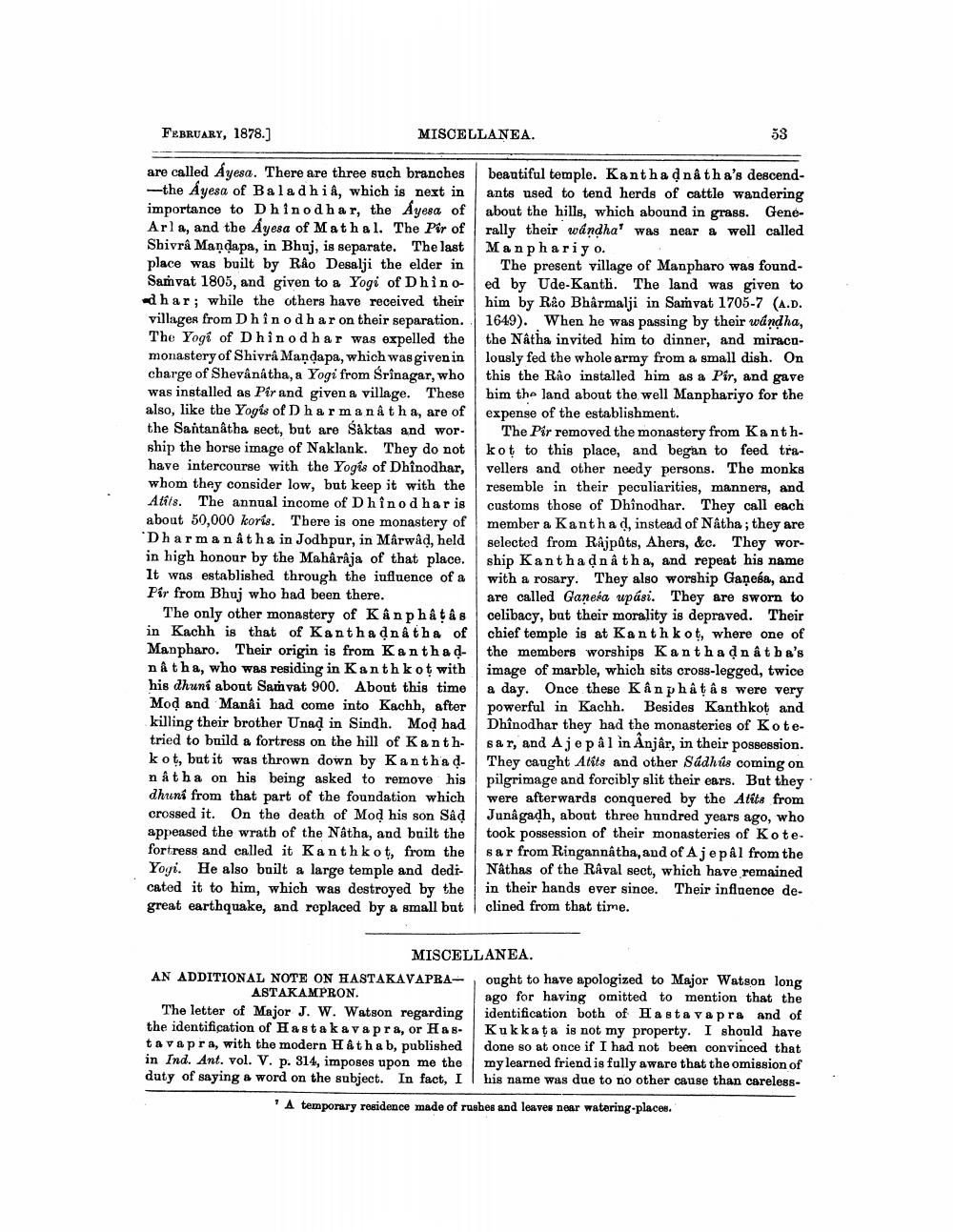________________
FEBRUARY, 1878.]
are called Ayesa. There are three such branches -the Ayesa of Baladhiâ, which is next in importance to Dhinodhar, the Ayesa of Arla, and the Ayesa of Mathal. The Pir of Shivra Mandapa, in Bhuj, is separate. The last place was built by Rão Desalji the elder in Samvat 1805, and given to a Yogi of Dhinodhar; while the others have received their villages from Dhinodhar on their separation. The Yogi of Dhinodhar was expelled the monastery of Shivrâ Mandapa, which was given in charge of Shevânâtha, a Yogi from Srinagar, who was installed as Pir and given a village. These also, like the Yogis of Dharma nå t h a, are of the Santanâtha sect, but are Saktas and worship the horse image of Naklank. They do not have intercourse with the Yogis of Dhinodhar, whom they consider low, but keep it with the Atits. The annual income of Dhinodhar is about 50,000 koris. There is one monastery of Dharmanatha in Jodhpur, in Mârwâd, held in high honour by the Maharaja of that place. It was established through the influence of a Pir from Bhuj who had been there.
MISCELLANEA.
The only other monastery of Kân phâțâs in Kachh is that of Kanthaḍnatha of Manpharo. Their origin is from Kanthad na tha, who was residing in Kanth kot with his dhuns about Samvat 900. About this time Mod and Manâi had come into Kachh, after killing their brother Unad in Sindh. Mod had tried to build a fortress on the hill of Kanthkot, but it was thrown down by Kanthaḍnatha on his being asked to remove his dhunt from that part of the foundation which crossed it. On the death of Mod his son Sâd appeased the wrath of the Nâtha, and built the fortress and called it Kanth kot, from the Yogi. He also built a large temple and dedicated it to him, which was destroyed by the great earthquake, and replaced by a small but
AN ADDITIONAL NOTE ON HASTAKAVAPRAASTAKAMPRON.
The letter of Major J. W. Watson regarding the identification of Hastakavapra, or Has tavapra, with the modern H &t hab, published in Ind. Ant. vol. V. p. 314, imposes upon me the duty of saying a word on the subject. In fact, I
beautiful temple. Kantha ḍnâ tha's descendants used to tend herds of cattle wandering about the hills, which abound in grass. Generally their wándha' was near a well called Manphariyo.
53
The present village of Manpharo was founded by Ude-Kanth. The land was given to him by Rao Bhârmalji in Samvat 1705-7 (A.D. 1649). When he was passing by their wandha, the Nâtha invited him to dinner, and miracnlously fed the whole army from a small dish. On this the Rao installed him as a Pir, and gave him the land about the well Manphariyo for the expense of the establishment.
MISCELLANEA.
The Pir removed the monastery from Kanthkot to this place, and began to feed travellers and other needy persons. The monks resemble in their peculiarities, manners, and customs those of Dhinodhar. They call each member a Kantha d, instead of Nâtha; they are selected from Rajpûts, Ahers, &c. They worship Kanthaḍnâ tha, and repeat his name with a rosary. They also worship Gaṇeśa, and are called Ganesa upúsi. They are sworn to celibacy, but their morality is depraved. Their chief temple is at Kanth kot, where one of the members worships Kanthaḍnâtba's image of marble, which sits cross-legged, twice a day. Once these Kân phâțâs were very powerful in Kachh. Besides Kanthkot and Dhînodhar they had the monasteries of Kotesar, and Aje pâ 1 in Ânjâr, in their possession. They caught Atits and other Sádhús coming on pilgrimage and forcibly slit their ears. But they were afterwards conquered by the Atits from Junagadh, about three hundred years ago, who took possession of their monasteries of Kotesar from Ringannâtha, and of Aje pâl from the Nathas of the Râval sect, which have remained in their hands ever since. Their influence declined from that time.
ought to have apologized to Major Watson long ago for having omitted to mention that the identification both of Hastava pra and of Kukkata is not my property. I should have done so at once if I had not been convinced that my learned friend is fully aware that the omission of his name was due to no other cause than careless
'A temporary residence made of rushes and leaves near watering-places.




